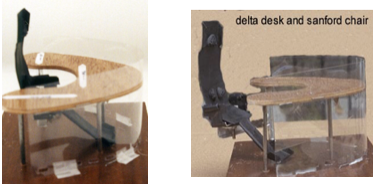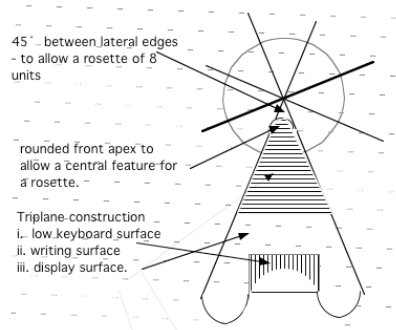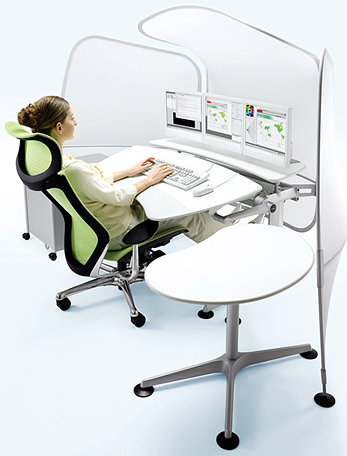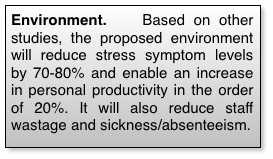From a wierd concept in 1998 to become disruptive in 2017? As predicted this is begining to emerge. The ‘Deskless Chair’ derived from the ergonomic importance of a reclined work position, is morphing into the ‘Workstation’. This should reduce the incidence of LBP and other health issues. It should also increase productivity.
We see a number of ‘work-station’ type models which include a reclined work mode and so are superior to the present (2016) upright conventional models. The work-chairs shown here are only semi-2T compliant and appear to ignore the science and are based on engineering. They do not invite a great uptake, inspite of extensive PR.
Okamura is a major Japanese company and produced the Atlas, a reclined work-chair that was ahead of the field in addressing the biomechanical factors that are necessary to 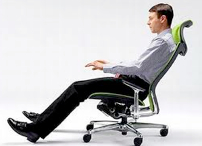 avoid or limit LBP.
avoid or limit LBP.
“Looks familiar, Henry?” was the message from John Jukes about this chair. Sure enough it showed the semi reclined work position that I had been advocating since 1998 on the web. . It has been suggested that Okamura designers had seen my web page. I doubt this as they had failed to apply the essential requirements need to make this a more user friendly, ergonomically optimised and cheaper  model. Their Atlas model allows some insights into where their design went wrong in relation to the 2Tilt (2T) concept.
model. Their Atlas model allows some insights into where their design went wrong in relation to the 2Tilt (2T) concept.
- It has a reasonably good reclined position. But then things become complicated as it differs from a chair designed along 2T principles.
- Problems occur with the further design and is unintentionally shown in the photograph, above, as the users head is not being supported. This illustrates the point that adjustments are usually maladjusted and have confusing controls.
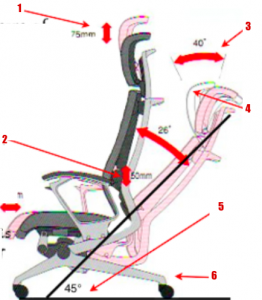
- 1. Good. Easily adjusted . One of the requirements for the 2Tilt concept for users of differing height.
- 2. Pelvic support should be fixed at 200 mm. (See BACKRESTS. Pelvic support v. Lumbar.→
- 3. Also no need for this adjustment or for the depth of the seat.
- 4. In the reclined mode the head-rest needs to be at about 6″ forward.
- 5. Good. The reclined back-rest angle is 45°. Better at 40° or less.
- 6. Good. The backward extended legs give greater stability in the reclined mode.
- Some adjustments should be avoided. (See ADJUSTMENTS?→ )
- The default upright mode is in the usual adverse mid-upright position. (The upright seated posture.→ )
- I found the shift from the reclined mode to be awkward due to adjustments.
- The 2T concept allows intermediate positions but these are unstable and can allow rocking exercise. (The unstable TRANSITIONAL MODE. It’s importance.↔ )
- The seat is convex and can allow the user to sit back and take advantage of the pelvic (‘iliac’) support. In this case the headrest has to be adjusted back from it’s position that is required when reclined. (see •3 above) (See‘Ischial Off Load system’).
- The user can also sit on the front edge where the seat is tilting downward as with a FTS. Slipping could be a problem.
- Fixed at a low level, the seat allows the feet to rest on the floor in the reclined mode, as shown. I am told that this causes problems for tall people who have tried it and an adjustable work-table may be required (no bad thing).
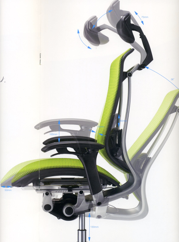 Designed and engineered to a high standard of sophistication but, again, there is a plethora of unnecessary adjustments with their controls which are so loved by contemporary designers. Most should be scrapped or disconnected by a user who is aware of the effect of adverse positions on spinal pathology.
Designed and engineered to a high standard of sophistication but, again, there is a plethora of unnecessary adjustments with their controls which are so loved by contemporary designers. Most should be scrapped or disconnected by a user who is aware of the effect of adverse positions on spinal pathology.- The brochure states, ”The lumbar support gives you comfortable support. You can adjust the lumbar support backward and forward up to 15 mm , and up and down to 60 mm.” The upright work position shown is acceptable as the ‘lumbar’ is actually ‘pelvic’ support provided it cannot be adjusted upwards above 20 cm.’. Gorman showed true ‘lumbar support‘,above 20 cm, to have the opposite effect to that desired and later confirmed by pMRI scans.
- The reclined mode is about 50° from the floor, a little short of the ideal 45° but acceptable. The figure given above is 26° from the illustrated upright mode. It relies on the ‘off-load’ domed seat. I prefer the forward tilted seat (FTS) but know of no evidence that shows one system to be better than the
An object of desire? Certainly not for me! Even ignoring it’s shortcomings, I found it far too large and clunky.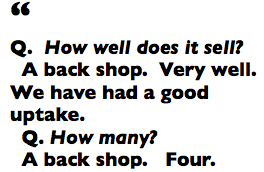
As predicted, a number of ‘work-chairs’ workstation type models are appearing which include a reclined work mode and so are superior to the present (2016) conventional upright models. Appearing to ignore the science and based on engineering they do not invite a great uptake inspite of extensive PR.
The ALTWORK chair
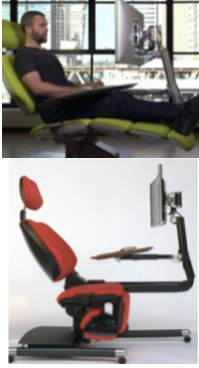 Now, in 2015, a chair is proposed, that has at least an upright and reclined work position. However deficient in biomechanics (ergonomic) optimisation it may be, with reservations, it is potentially the best work-chair in the market at that time. (http://altwork.com). It also has a ‘stand’ facility so in this respect is approaching the 4M workstation→. It incorporates iliac support (at least, I hope iliac and not lumbar), which is required in the upright mode but might be excessive for the reclined mode. The reclined configuration can be deeply adverse as can be found in some dental reclined chairs. There appears
Now, in 2015, a chair is proposed, that has at least an upright and reclined work position. However deficient in biomechanics (ergonomic) optimisation it may be, with reservations, it is potentially the best work-chair in the market at that time. (http://altwork.com). It also has a ‘stand’ facility so in this respect is approaching the 4M workstation→. It incorporates iliac support (at least, I hope iliac and not lumbar), which is required in the upright mode but might be excessive for the reclined mode. The reclined configuration can be deeply adverse as can be found in some dental reclined chairs. There appears 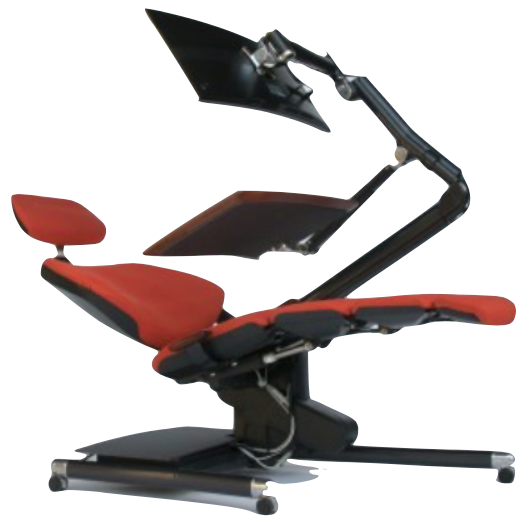 to be intermediate position adjustment in the transitional mode, which at best, gives no biomechanic advantage and was probably intended to add comfort → . Misled by ” that treacherous guide which only turns up truthfully when the ergonomics are fully correct”. If this mode becomes a part of the unstable intermediate mode it allows a faster transition and also gives the user the choice for dynamic motion and rehabilitation. A win-win. Scrapping a fixed intermediate mode reduces manufacturing costs. These faults could easily be corrected and so with reservations, it is potentially the best work-chair in the market.
to be intermediate position adjustment in the transitional mode, which at best, gives no biomechanic advantage and was probably intended to add comfort → . Misled by ” that treacherous guide which only turns up truthfully when the ergonomics are fully correct”. If this mode becomes a part of the unstable intermediate mode it allows a faster transition and also gives the user the choice for dynamic motion and rehabilitation. A win-win. Scrapping a fixed intermediate mode reduces manufacturing costs. These faults could easily be corrected and so with reservations, it is potentially the best work-chair in the market.
Not having had an opportunity to see this chair, I cannot comment further on the ergonomics. Expensive at $5,900, it looks over engineered, awkward and too clunky for an ‘object of desire’. ☛ Art, Elegance and Objects of Desire→ Did they arrive at this independently or did they see my web-page for the 2T concept? This has been in the public domain since 1998, later upgrade to the 3M (2T = 3M) & 4M I fear it was the latter and the chance of a simpler, more ergonomically optimised and more elegant model was missed. Also the aesthetics worried me. I penned a hurried post on this subject.(ALTWORK & Art →)
Uptake and ‘Object of Desire’?
Appearing to ignore the science and based on engineering they do not appear to invite a great uptake inspite of extensive PR.
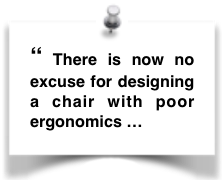 Why? Ignoring the the essential 2T requirements for an absence of adjustments and controls the models are clunky and not appealing. The 2T simplicity reduces costs, improves function, improves ergonomics and enables a simpler and more elegant design.
Why? Ignoring the the essential 2T requirements for an absence of adjustments and controls the models are clunky and not appealing. The 2T simplicity reduces costs, improves function, improves ergonomics and enables a simpler and more elegant design.
For existing manufacturers this provides an opportunity and for any entering the field. Top manufacturers are already recognising that they have come to the end of the line for ergonomics. Backache (LBP) and other spinal & muscle-skeletal conditions still persist resulting in stress and lowered productivity. Will they grab this opportunity or be held back by Familiarity bias →?
Ergoquest
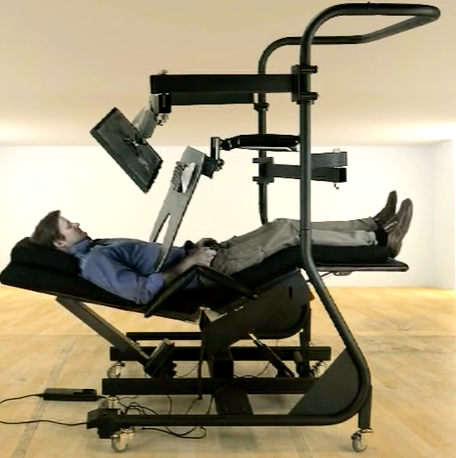 A good idea in that it achieves the 2 modes but what a terrible design! Electrically operated. With all possible bells and whistles It represents an almost opposite view to the 2T principle and it’s 4M workstation derivative. Price: $5995
A good idea in that it achieves the 2 modes but what a terrible design! Electrically operated. With all possible bells and whistles It represents an almost opposite view to the 2T principle and it’s 4M workstation derivative. Price: $5995
The CHOTTO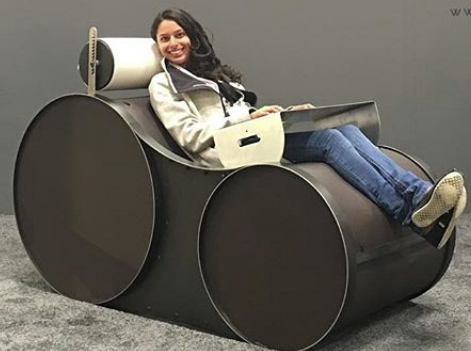
This highly innovative chair was introduced to me by it’s designer,Thomas Stroman. He wrote to me “I am an architect by training, but having experienced back surgery, my focus has been on ergonomic seating design for human-computer interaction.” At first glance one might be excused for thinking that it looked as if it were self mobile with caterpillar tracks. Perhaps an exciting concept for the future. What fun to go charging around the workspace and bumping one’s colleagues! → www.stromandesign.com and The CHOTTO→
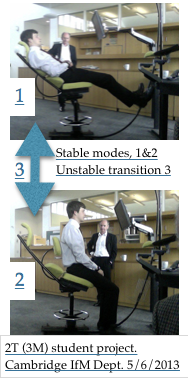 Now have a look at the 2013 Cambridge student project on the 2T CONCEPT. The Cambridge trials showed the elegance, simplicity, cost effectiveness and greatly enhanced ergonomics of th 2T concept showing a 4M version. This was evident to both staff and students, The model demonstrated was a cannabalised version of the p1 prototype which had been formed from Electric tubular conduiting in the basement of the Cromwell Hospital with help from the electrician.
Now have a look at the 2013 Cambridge student project on the 2T CONCEPT. The Cambridge trials showed the elegance, simplicity, cost effectiveness and greatly enhanced ergonomics of th 2T concept showing a 4M version. This was evident to both staff and students, The model demonstrated was a cannabalised version of the p1 prototype which had been formed from Electric tubular conduiting in the basement of the Cromwell Hospital with help from the electrician.
It excited comments “Gee! That’s cool. I want it.” so although simple it is an ‘An object of Desire’ at a student level. Let us see what designers can do with the newer materials for the top end of the market. Go consider!
(Yes! That’s John Gorman glowering in the background. He was an engineering graduate and took the opportunity to visit his ‘Alma mater’).
And a sketch for a 2T model done for me by Aaron Chetwynd in about 2000, which deliberately resembles existing chairs so as to avoid familiarity bias. compare it’s simplicity with the next chairs. http://www.aaronchetwynd.com→
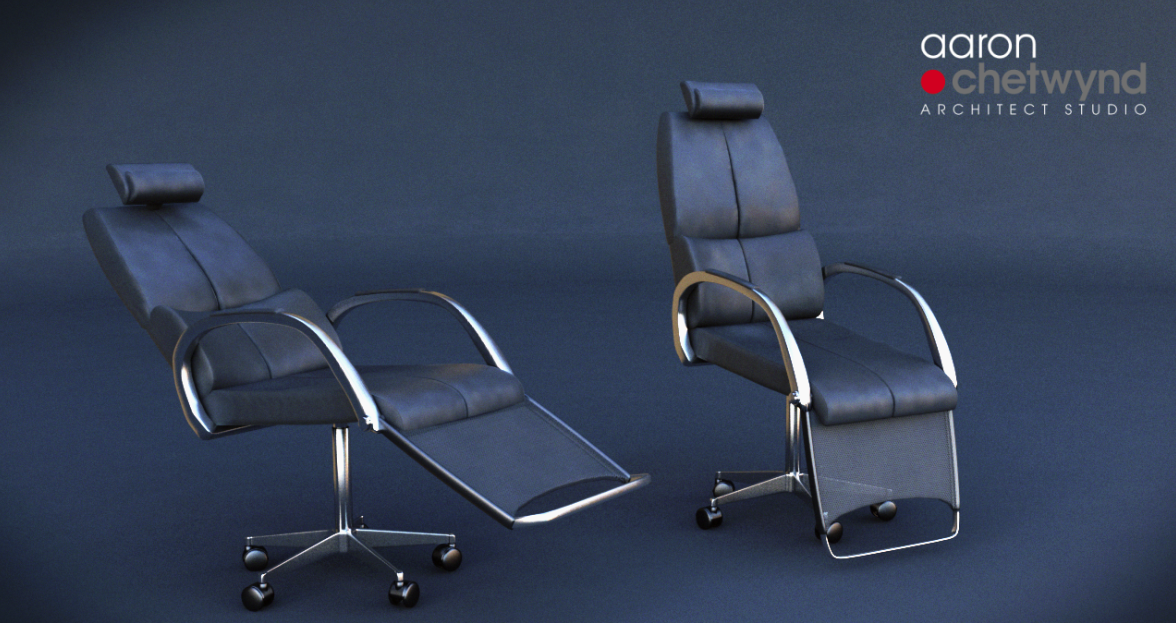
GTRACING Gaming Office Chair
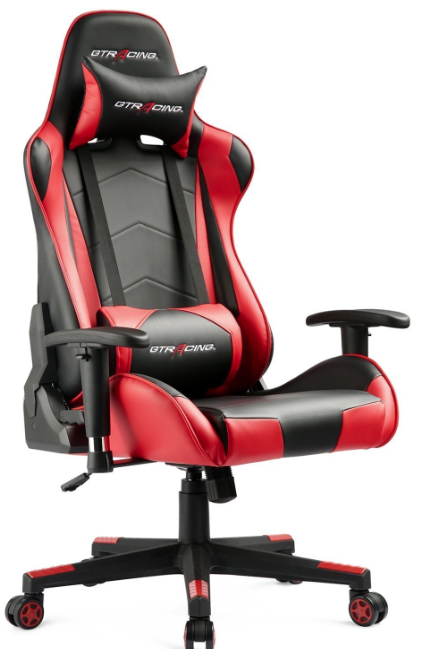 The ‘Game Racing Chair the top end of this version ($166), with a reclined mode and an upright mode with potential pelvic support, is coming
The ‘Game Racing Chair the top end of this version ($166), with a reclined mode and an upright mode with potential pelvic support, is coming 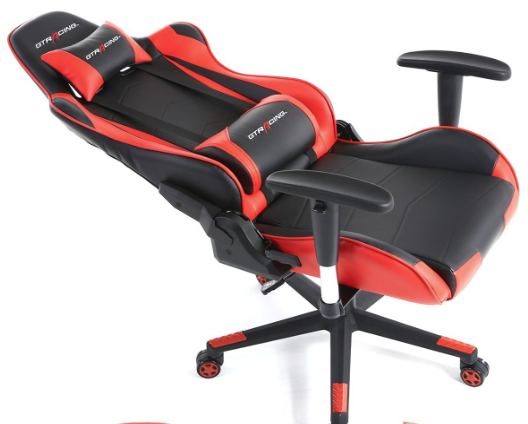 close to the 2T design concept but lacks simplicity and optimised functionality. The ‘Ergonomic Backrest’, is spoilt by being adjustable. Pillows are OK but just not good design. Recliner Swivel Rocker Headrest sounds good. https://www.gtomegaracing.com/gt-omega-racing-gaming-office-chair-seats .
close to the 2T design concept but lacks simplicity and optimised functionality. The ‘Ergonomic Backrest’, is spoilt by being adjustable. Pillows are OK but just not good design. Recliner Swivel Rocker Headrest sounds good. https://www.gtomegaracing.com/gt-omega-racing-gaming-office-chair-seats .
Aircraft seating
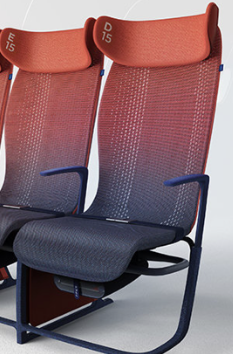 This seems to be always ahead of Office seating. Benjamin Hubert of LAYER recently collaborated with Airbus to redesign economy class airline seating. From the photographs this is hardly ergonomically impressive but the fabric claims interesting ‘all singing, all dancing properties’. These include a knit seat cover with zones of various density that offer customized levels of support to the body and automatically adjust, based on weight and movement. This is made possible by passing current through the conductive yarn to vary the seat tension. The accompanying Move App, which when connected with the smart textiles gives users control over factors –like seat tension, temperature, pressure and movement. Presets include “massage”, “mealtime”, or “sleep”. This may have ‘legs’, as a means to approach the 2T design concept, by reducing the overall complexity of seat construction, probably lowering cost of both seat and its tooling and by restraining overall weight, enabling a potential tilt mechanism to be less stressed and easier to control. (Peter Bessey suggests)
This seems to be always ahead of Office seating. Benjamin Hubert of LAYER recently collaborated with Airbus to redesign economy class airline seating. From the photographs this is hardly ergonomically impressive but the fabric claims interesting ‘all singing, all dancing properties’. These include a knit seat cover with zones of various density that offer customized levels of support to the body and automatically adjust, based on weight and movement. This is made possible by passing current through the conductive yarn to vary the seat tension. The accompanying Move App, which when connected with the smart textiles gives users control over factors –like seat tension, temperature, pressure and movement. Presets include “massage”, “mealtime”, or “sleep”. This may have ‘legs’, as a means to approach the 2T design concept, by reducing the overall complexity of seat construction, probably lowering cost of both seat and its tooling and by restraining overall weight, enabling a potential tilt mechanism to be less stressed and easier to control. (Peter Bessey suggests)
How do concepts evolve?
In 1903 Ford’s ‘Horseless Carriage’ had morphed into the Model T, capable of 20 horsepower In 1908. This, at least, solved the “great horse manure crisis of 1894” when it was suggested that London’s streets would be clogged in 9 feet of horse manure in 50 years. It’s descendants are, in turn, being disrupted by ‘the driverless car’. Disruptive technologies have to prove themselves 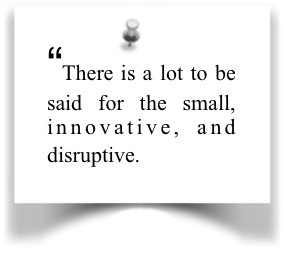 first. They do so by working on the same infrastructure as the incumbent leaders. Cars had to run on the same streets as horses. Dial-up internet connections in the late 1990s used the copper in the phone networks. So, work-stations have to use existing office spaces before becoming universal. (Dan Denning, Publisher, Southbank Investment Research ).
first. They do so by working on the same infrastructure as the incumbent leaders. Cars had to run on the same streets as horses. Dial-up internet connections in the late 1990s used the copper in the phone networks. So, work-stations have to use existing office spaces before becoming universal. (Dan Denning, Publisher, Southbank Investment Research ).
Peter Bessey wrote (30/6/2016) “It has taken time for the market to build, but there is definitely a movement toward other postures in the workplace. While some of that has derived from posture investigation and potential for beneficial effects on the user, other advances have emerged as a response to changing technology, new materials and a non-paper work method, as seen from the 60’s onward. I suspect that a NASA effect is involved in some of this too. Numerous resources have been directed into space travel in recent decades and, for human travellers, that has mostly incorporated a reclined support system to encourage stress-reduction during high-load take-off and landing. So there has been a real effort to ensure that anthropomorphic needs are addressed properly when working from that position, to ensure equipment control systems can be operated successfully and without long-term harm. There have been a number of attempts to create pod-like structures around reclined positions, to create controlled environments for audio enjoyment, meditation and relaxation. Perhaps those too, have influenced the current trend? But the main factor may well just simply be the instant communication and data access that today’s world now has available for sharing ideas. Apart from that, it is likely that this trend has derived from the typical and gradual process in which increased knowledge, enlarged awareness and advance in technology brings. Stale markets, where things have remained much the same for decades and highly competitive markets where a cycle of fashion and small detail differences are all the consumer sees on offer, can drive the introduction of disruptive design ideas and encourage new entrants to challenge the existing status quo. Perhaps that is what we are beginning to see Best regards Peter”
For further reading, see ☛
- An account by Dutch futurologists → The end of sitting?
- How major factors will impct on sitting → The global future?
- A way that tech.is going → VR and sitting
- A treacherous guide → COMFORT
- Designers beware → Familiarity bias

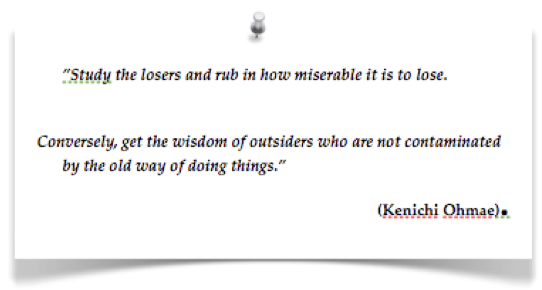

 PRODUCTIVITY AND WORKPLACE STRESSORS
PRODUCTIVITY AND WORKPLACE STRESSORS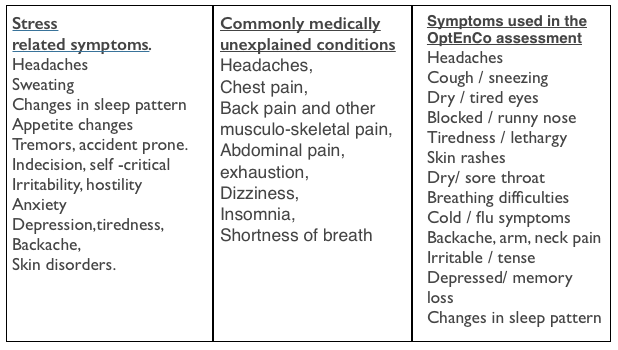
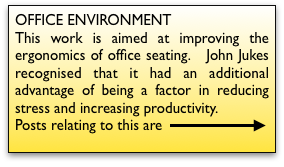
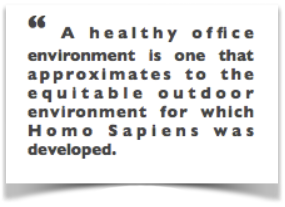
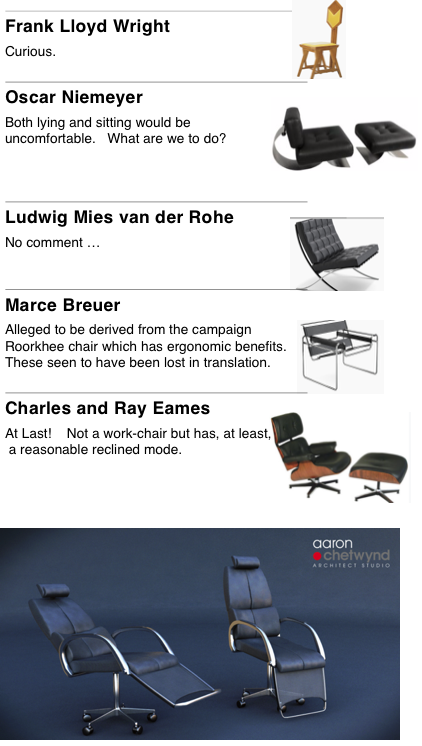
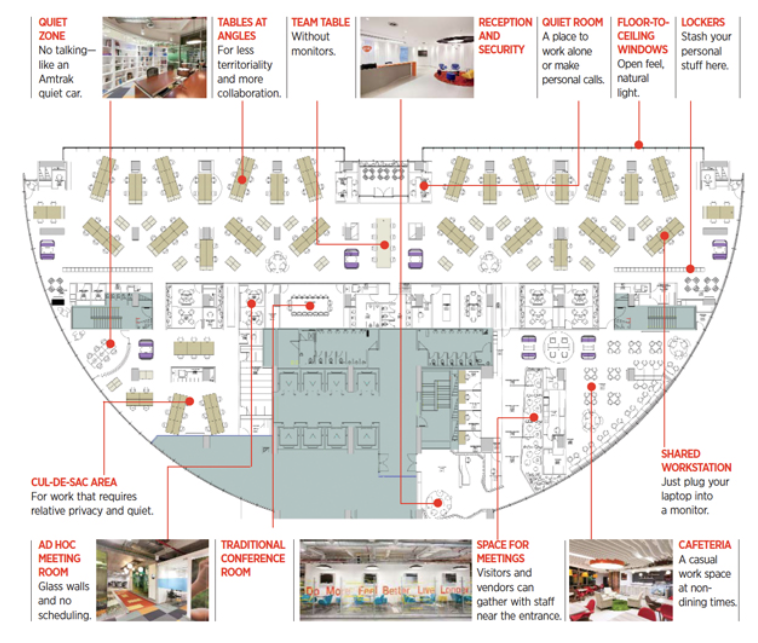
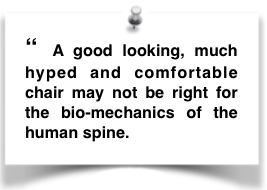
 For a discursive account→
For a discursive account→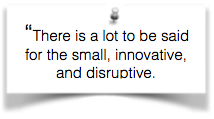
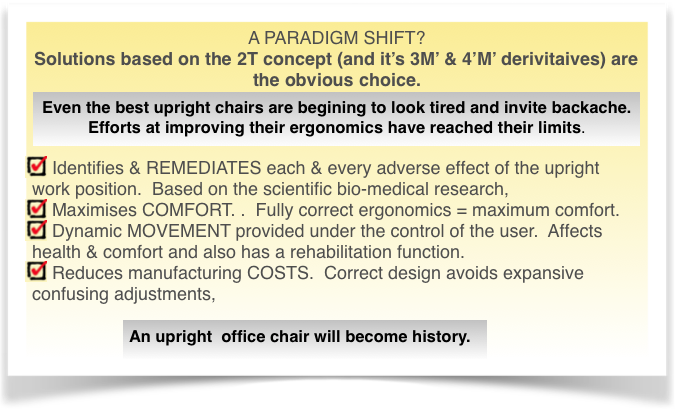
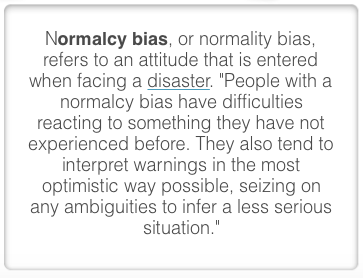 The bias holdup. Failure to understand
The bias holdup. Failure to understand 
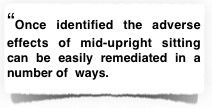
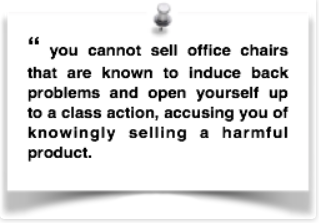 There is a step beyond this. Once the notion of ‘good sitting’ becomes not only well understood but also well accepted – and I think we have enough clarity from all the work that Dr Henry has pulled together, and enough medical agreement about that work, for this to happen – there comes
There is a step beyond this. Once the notion of ‘good sitting’ becomes not only well understood but also well accepted – and I think we have enough clarity from all the work that Dr Henry has pulled together, and enough medical agreement about that work, for this to happen – there comes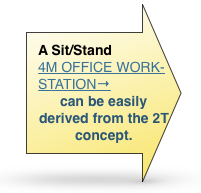
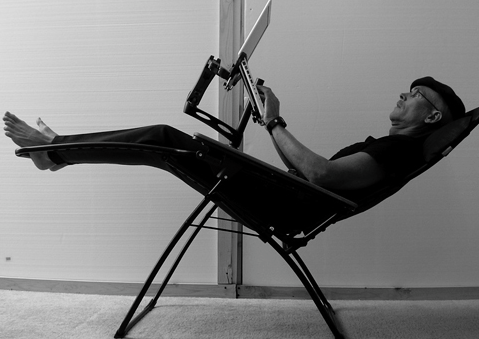 A reclined chair from America. With some added work facilities. Hardly an Office chair.
A reclined chair from America. With some added work facilities. Hardly an Office chair.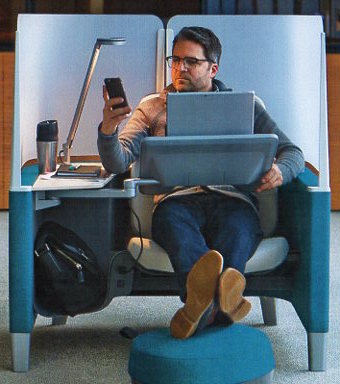
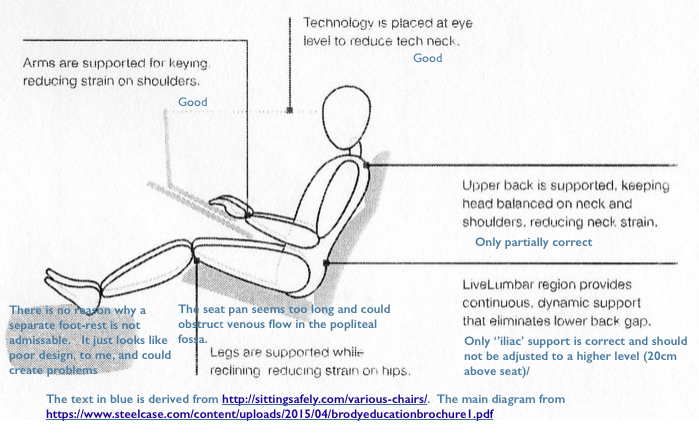

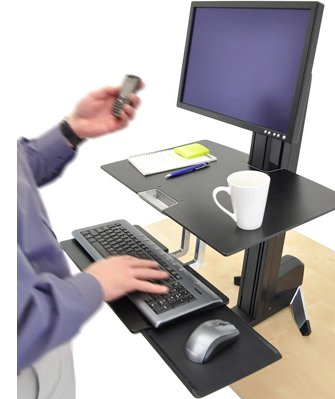
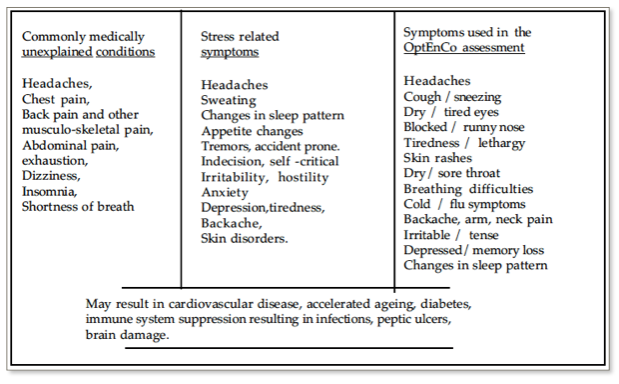

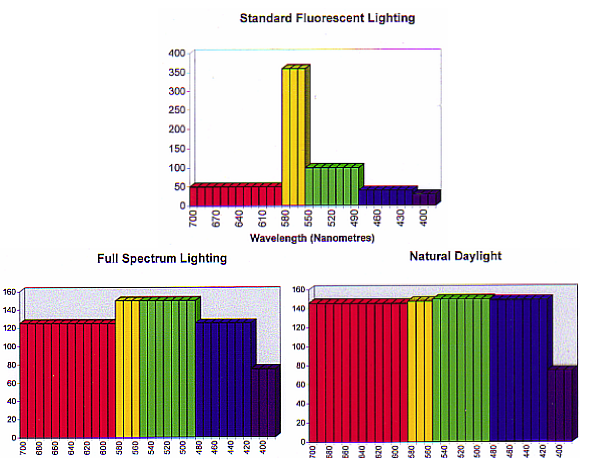
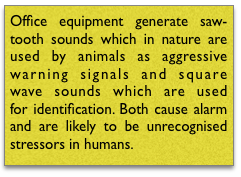
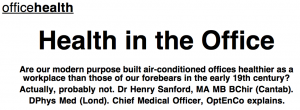
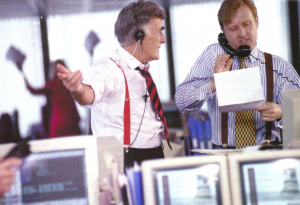
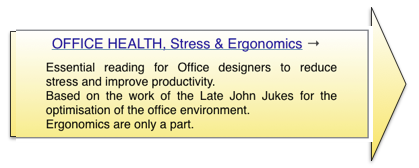
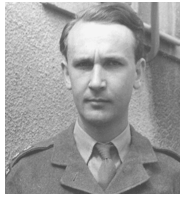

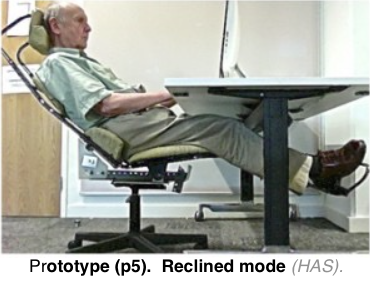 In an office with cheap, ordinary desks a
In an office with cheap, ordinary desks a 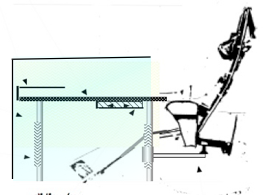 The chair can rotate to face through 270 ̇ Cabling can be led straight to the chair(telephone, computer, adjustments).
The chair can rotate to face through 270 ̇ Cabling can be led straight to the chair(telephone, computer, adjustments).